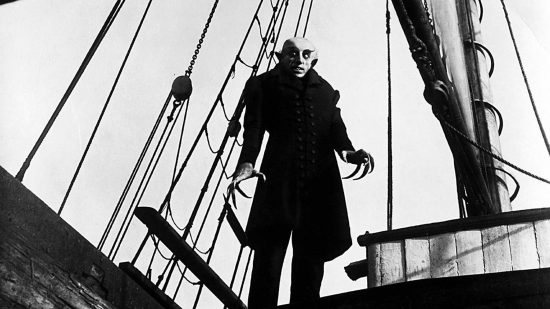Late To The Party: F.W Murnau’s Nosferatu
If like me, you consider yourself to be a movie fan and a bit of a film buff, you will be familiar with this situation: You are in the pub, at work or at a party and you tell someone that you love watching films, you have done for years. You begin to talk about various films you both like, which genres, actors and directors you prefer and why. But then, as inevitable as that oncoming subway train Mr. Anderson, they ask you about a famous film you never got around to watching. You have to confess to not having seen it yet. There is a moment of silent judgement, followed by, ‘Whaaa?’ and their faith in your opinion is cast to the wind, like Donny’s ashes.
These reviews, ranging from classical masterpieces to modern-day blockbusters that I have never seen before are not only my confession but also my absolution from the judgement of the film universe. I am Fredo, in the boat. Hail Mary, full of grace.
The inaugural review is the iconic vampire film, F.W Murnau’s 1922 classic, Nosferatu. Based on Bram Stoker’s Dracula, with a script written by Henrik Galeen, it changes the names of the characters in an attempt to avoid having to credit and therefore pay the Stoker estate. In place of Count Dracula we have Count Orlok, Jonathan Harker is Hutter and Mina is Ellen. The attempt at avoiding copyright failed and the production company that released Nosferatu declared bankruptcy to avoid paying royalties. As a consequence, under a court order, all prints of the film were ordered to be destroyed. Thankfully, a few copies survived, having already shown around the world.
The story follows Hutter, a young estate agent from Wisbourg in Germany who travels to Transylvania to facilitate the sale of a large house, opposite his own, to the mysterious Count Orlok. Hutter is young, arrogant, and dismissive of the Transylvanian locals’ fears of the Count; a young estate agent who is a bit of a dick. It’s good to know some things never change. It is only when inside Orlok’s castle that he begins to suspect the count of having nefarious motives and is not all that he appears to be.
The film was part of the German Expressionist movement of the late 1910s and 20s, with other famous examples such as The Cabinet Of Dr. Caligari and Metropolis. The Expressionist movement in film is partly defined by an emphasis on a stylised aesthetic of theatrical sets with peculiar angles, shadows, and unusual sources of light that emphasize a character’s emotional or mental state within a scene. Nosferatu, however, is not wholly expressionist in its cinematography, but a hybrid, especially when compared to purer examples of the movement, such as Dr. Caligari. The film has many exterior shots, using natural light and settings as we follow Hutter on his initial journey through Germany and on to Transylvania, before he is tainted by his encounter with Orlok. It is only when we are finally in the company of Orlok, some 20 minutes into the film that the sets become strange, shadows encroach on the screen and the world is a darker place.
The darkness shifts up a gear when we board The Demeter, as damned a boat as there ever has been in fiction and film. Orlok reveals his true nature to us, a demon that stalks its prey with cruel ruthlessness, as much feeding on fear as it does blood.
Watching with an eye used to modern-day pacing and narratives, Nosferatu is a hypnotic experience, slow compared to modern fare. But such films need to be viewed with a sense of context and perspective. It still holds a magical quality, from the way the Count’s coach and horses glide like a floating funeral procession, the shadow stalking its way up the stairs to Ellen’s bedroom and the iconic shot of the Count rising unaided out of his tomb. These images have become synonymous with all things vampire in popular culture.
Performances are large and expressive, born out of the traditions of vaudeville and music-hall theatre. Many of the actors would have cut their teeth on stages where they had to compete with loud, uninhibited audiences that are nothing like the quiet and mainly respectful theatre audiences of today. The actors’ expressions need to carry whole paragraphs of script, rarely allowing for the subtleties and nuances of a close-up.
The influence of Nosferatu cannot be underestimated. Although the film was not a financial success due to the court case, it was popular around the world. It paved the way for Hollywood’s own version of Dracula, which alongside James Whale’s Frankenstein helped create Universal’s Monster Universe, a franchise it is still trying to get right. In Tobe Hooper’s adaption of Stephen King’s Salem’s Lot the similarity of the vampire is striking. Homages can be seen in 30 Days Of Night and the wonderful What We Do In The Shadows. But there are other more indirect influences Nosferatu and expressionist cinema, in general, has had. Hitchcock worked as an Assistant Director at Berlin’s Babelsberg studios in 1924 and the style influenced many of his films including Psycho, The Birds, and Vertigo. The use of shadows and angles in Carol Reed’s The Third Man is clearly expressionist. The films of Tim Burton such as Edward Scissorhands, Beetlejuice and particularly Batman Returns are full of the visual themes of shadow, strange angles, and gothic sensibilities.
Nosferatu is no longer a scary horror film to watch. As an audience, we are all too long in the tooth and desensitized to the graphic nature of modern horror films from John Carpenter’s paranoid masterpiece, The Thing to the torture porn of films such as Hostel and Saw. But it does still stay with you. It is haunting and the visuals are striking and iconic. It is surely the first entry in a very long and impressive family tree… of horror.










